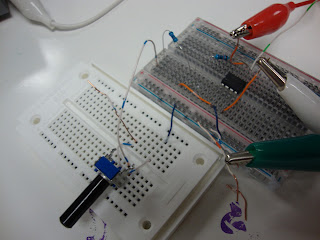Procedure:
We connect the oscilloscope with a frequency generation.
Exercise 1: Sinusoid
 |
| f = 5 kHz, V = 5V |
Period = 0.2 ms
Peak to Peak = 11.4 V
Zero to Peak = 5.8 V
Anticipated RMS = 3.53 V
Using DMM to take Voltage values
VDC = 0.026 mV
VAC = 3.35 V
The VAC is close to our anticipated RMS value.
Exercise 2: Include DC Offset
We add an offset of 2.5 V, and another one at 5V
 |
| DC Coupling at 5V |
 |
| AC Coupling at 5V |
2.5V offset measurements:
VDC = 2.51 V
VAC = 3.37 V
The VDC shows the offset in the output like the graph while the offset does not affect VAC.
Exercise 3: Square Wave with offset
VDC = 10 mV
VAC = 5.34 V
The measured value was close to the theoretical VAC = 5 V.
Exercise 4: Mystery Signal
 |
| Mystery Signal |
f = 70.42 Hz
Pk-Pk = 940 mV
Conclusion:
The lab was a success showing that it is more useful to use a digital oscilloscope to analyze waves than the heavy traditional ones.














